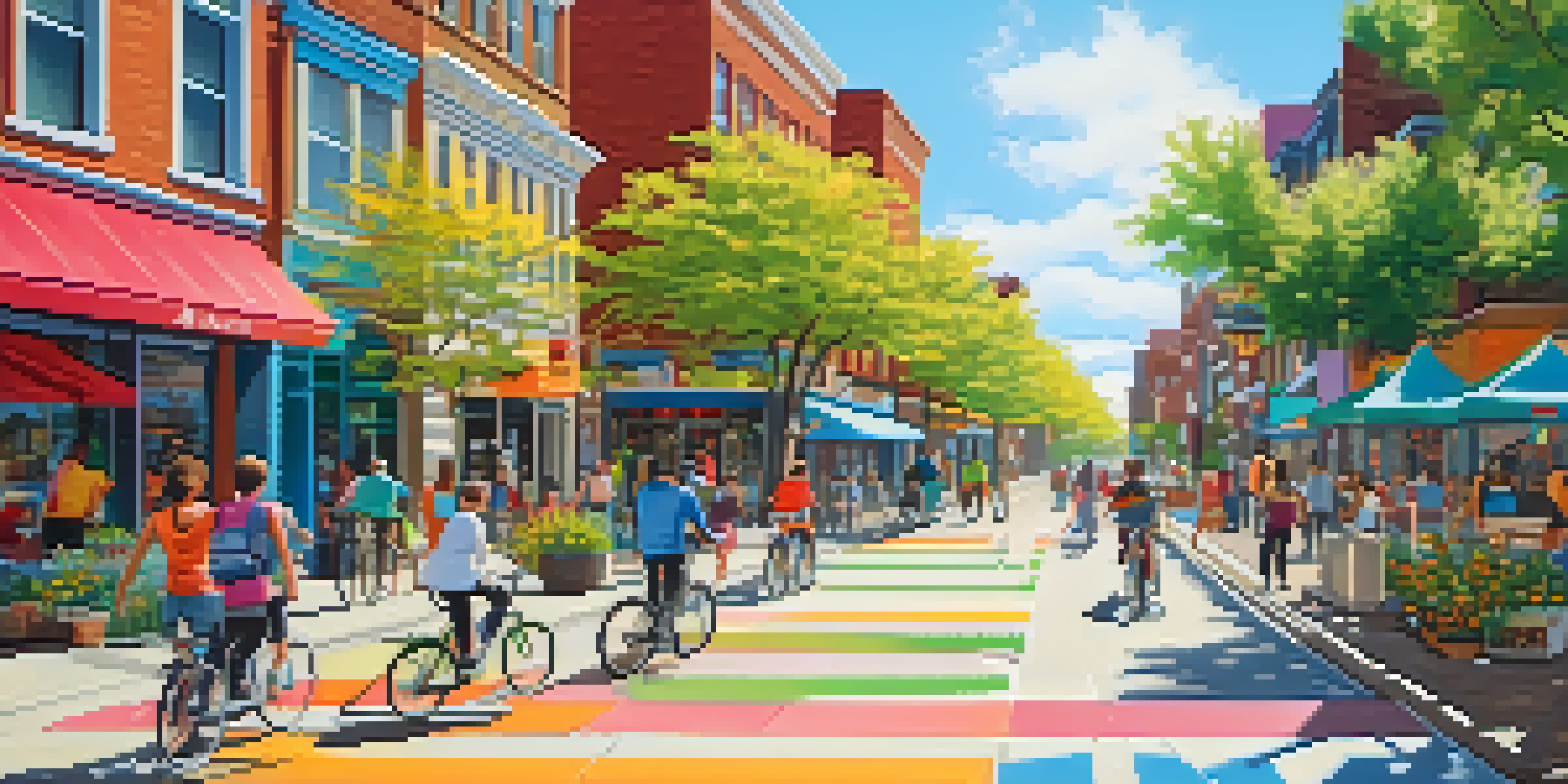Building Healthy Communities Through Active Transportation Initiatives

Understanding Active Transportation and Its Benefits
Active transportation encompasses walking, cycling, and other forms of non-motorized travel. It promotes physical fitness by encouraging people to incorporate movement into their daily routines. For instance, opting to bike to work instead of driving can significantly improve cardiovascular health and reduce stress levels.
Active transportation is not just a means of getting from point A to point B; it’s a way to enhance our health, environment, and communities.
Moreover, active transportation benefits communities by reducing traffic congestion and lowering pollution levels. When more people choose to walk or cycle, there are fewer vehicles on the road, leading to cleaner air and quieter neighborhoods. This not only enhances the quality of life for residents but also attracts visitors and potential new businesses.
Additionally, active transportation creates opportunities for social interaction and community engagement. As people walk or bike together, they naturally connect with one another, fostering a sense of belonging and shared responsibility for their environment.
Key Components of Active Transportation Initiatives
Successful active transportation initiatives often include infrastructure improvements such as bike lanes, sidewalks, and pedestrian crossings. These features make it safer and more convenient for people to choose walking or biking over driving. For example, cities like Amsterdam have invested heavily in cycling infrastructure, resulting in a vibrant biking culture.

Public transportation options that integrate with active transportation also play a vital role. When bus and train stations are designed with bike racks and pedestrian-friendly pathways, it encourages commuters to incorporate multiple modes of transport into their daily routines. This seamless connectivity enhances the overall effectiveness of active transportation.
Active Transportation Enhances Health
Incorporating walking and cycling into daily routines promotes physical fitness and mental well-being.
Community programs that promote walking and biking can further bolster these initiatives. Events like 'Bike to Work Day' or walking school buses for children create excitement and awareness around the benefits of active transportation, motivating more individuals to participate.
The Role of Local Governments in Promoting Active Transportation
Local governments are crucial in shaping the policies and infrastructure that support active transportation. By prioritizing pedestrian-friendly planning in urban development, they can create environments that naturally encourage walking and cycling. For example, cities can implement zoning laws that promote mixed-use developments, making it easier for residents to access amenities without a car.
The best way to predict the future is to create it, and creating a future that emphasizes active transportation is a step toward better urban living.
Funding for active transportation projects is another area where local governments can make a significant impact. By allocating budget resources toward building bike lanes, improving sidewalks, and creating safe crossings, they demonstrate a commitment to fostering healthier communities. Grants and partnerships with organizations can also provide additional support for these initiatives.
Moreover, local governments can lead by example by promoting active transportation among their employees. Encouraging staff to cycle or walk to work, or even providing incentives for using public transport, can set a positive precedent for the community.
Community Involvement: Engaging Residents in Active Transportation
Community involvement is essential for the success of active transportation initiatives. Engaging residents in the planning process ensures that their needs and preferences are considered. This can be achieved through surveys, public meetings, and workshops that invite feedback and ideas from community members.
Building local coalitions or partnerships with schools, businesses, and health organizations can further enhance participation. When diverse stakeholders come together to promote active transportation, it creates a unified message that resonates throughout the community. For example, a partnership between a local health clinic and a community group could organize walking challenges to motivate residents.
Community Engagement is Key
Involving residents in planning and promoting active transportation initiatives fosters a sense of belonging and shared responsibility.
Additionally, celebrating successes through events and recognition programs can inspire continued engagement. Highlighting individuals or organizations that make strides in promoting active transportation fosters a sense of pride and encourages others to join in.
Addressing Barriers to Active Transportation
While active transportation has numerous benefits, there are challenges that can deter individuals from participating. Safety concerns, inadequate infrastructure, and a lack of knowledge about routes can discourage people from walking or cycling. Addressing these barriers is essential to promote widespread adoption.
For instance, implementing better lighting, signage, and maintenance of pathways can alleviate safety worries. Creating well-marked bike lanes and pedestrian paths ensures that users feel secure while navigating their communities. Additionally, educating residents about safe biking practices and local routes can empower them to choose active transportation.
Community-based programs that offer support, such as bike repair workshops or walking groups, can also help overcome these barriers. These initiatives not only provide practical assistance but also create a supportive network that encourages newcomers to embrace active transportation.
The Environmental Impact of Active Transportation
Active transportation significantly contributes to environmental sustainability by reducing greenhouse gas emissions. When individuals choose to walk, bike, or use public transport instead of driving, they decrease their carbon footprint. For example, cities that promote cycling as a primary mode of transportation often experience improved air quality and reduced urban heat.
Furthermore, less reliance on cars can lead to decreased road maintenance costs and less land being consumed for parking lots. This opens up opportunities for creating green spaces and parks that enhance community well-being. Imagine a bustling city transformed by bike paths and pedestrian plazas instead of endless asphalt.
Environmental Benefits of Active Travel
Active transportation reduces greenhouse gas emissions and contributes to cleaner air and greener urban spaces.
Active transportation also fosters a greater appreciation for local ecosystems. As people engage more with their surroundings while walking or biking, they become more connected to nature and motivated to protect it. This awareness can translate into community-led environmental initiatives that benefit both residents and the planet.
Measuring the Success of Active Transportation Initiatives
To ensure the effectiveness of active transportation initiatives, it's essential to establish clear metrics for success. This could include tracking the number of cyclists and pedestrians in specific areas, monitoring reductions in vehicle traffic, or measuring improvements in public health outcomes. Regular assessments help gauge progress and identify areas for improvement.
Community feedback plays a critical role in measuring success as well. Surveys and focus groups can provide insights into residents' experiences with active transportation options, helping to refine programs and policies. This ongoing dialogue fosters a sense of ownership among community members and encourages continued participation.

Lastly, sharing success stories and data with the public can inspire further engagement. Highlighting positive changes in health statistics, environmental impacts, or community feedback can motivate others to embrace active transportation and advocate for additional improvements.